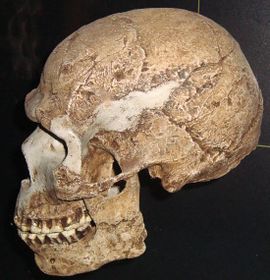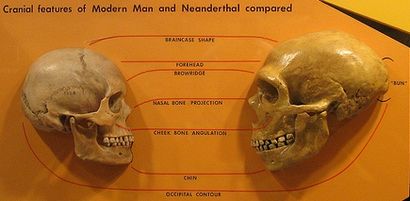إنسان عاقل
| إنسان عاقل | |
|---|---|

| |
| Male and female H s. sapiens (Akha in northern Thailand, 2010 photograph) | |
| التصنيف العلمي | |
| أصنوفة غير معروفة (أصلحها): | الحياة |
| مملكة: | الحيوانية |
| Phylum: | حبليات |
| Class: | الثدييات |
| تحت رتبة: | جافة الأنف |
| فوق رتبة: | القرديات |
| الجنس: | هومو |
| Species: | H. sapiens
|
| Binomial name | |
| Homo sapiens Linnaeus, 1758
| |
| Subspecies | |
|
H. s. sapiens | |
الإنسان العاقل هو الاسم المنهجي المستخدم في التصنيف (تُعرف أيضاً بالتسمية الثنائية) للنوع البشرية الوحيد الباقي. وهو التسمية اللاتينية "للإنسان العاقل" وقد طرحه كارولوس لينايوس عام 1758 (ويعتبر في حد ذاته عينة نمطية).
الأنواع المنقرضة من جنس هومو تشمل الإنسان المنتصب، الذي كان موجوداً منذ 1.8 إلى 0.1 مليون سنة مضت، وعدد آخر من الأنواع (التي يعتبرها بعض المؤلفين أنواع فرعية من الإنسان العاقل أو الإنسان المنتصب). الإنسان العاقل الأول (2003) وهو نوع فرعي منقرض مقترح من الإنسان العاقل.
عمر انتواع الإنسان العاقل من سلفه الإنسان المنتصب (أو الأنواع الوسيطة مثل إنسان هايدلبرگ) يقدر بأنه وقع منذ حوالي 200.000 سنة مضت.
يعرف بأن الاختلاط العتيق قد وقع في أفريقيا و(التوسع الحديث التالي خارج أفريقيا) وأوراسيا، من 100.000-30.000 سنة مضت.
بشكل أكثر تحديداً، فإن مصطلح الإنسان الحديث تشريحياً[2] (AMH) يستخدم للتمييز بين الإنسان العاقل باعتباره متوافق تشريحياً مع مجموعة من الطرز الظاهرية كما في الإنسان المعاصر عن مجموعة الأنواع المنقرضة من الإنسان العتيق. ويعتبر هذا الأمر مفيداً بصفة خاصة للأزمنة والمناطق التي يتواجد فيها الإنسان الحديث تشريحياً والإنسان العتيق معاً، على سبيل المثال، في أوروپا العصر الحجري القديم.
الاسم والتصنيف
الأعراق البشرية الحالية للتصنيفات الحديثة ::
أفارقة وعرب وآسيويين وهنود وأوروبيين والأمريكان الأصليين
العمر وعملية تحديد النوع

الاشتقاق من الإنسان المنتصب

الإنسان العاقل المبكر

التشتت والاختلاط العتيق
التشريح
الحداث التشريحية
التشريح القحفي

(في متحف كلڤلاند للتاريخ الطبيعي)
Features compared are the braincase shape, forehead, browridge, nasal bone, projection, cheek bone angulation, chin and occipital contour
تشريح الفك
بنية الهيكل العظمي
التطور الأخير
الحداثة السلوكية
تؤمن الديانات الإبراهيمية أن الإنسان الحالي بني أدم وليس نتيجة نظريات التطور والتحور,
وهي غير نظريات التطور الرائجة ::
https://www.youtube.com/watch?v=DZv8VyIQ7YU
قراءات إضافية
- Reich, David (2018). Who We Are And How We Got Here - Ancient DNA and the New Science of the Human Past. Pantheon Books. ISBN 978-1101870327.[5]
المصادر
- ^ Global Mammal Assessment Team (2008). "Homo sapiens". The IUCN Red List of Threatened Species. IUCN. 2008: e.T136584A4313662. doi:10.2305/IUCN.UK.2008.RLTS.T136584A4313662.en. Retrieved 12 January 2018.
- ^ Nitecki, Matthew H. and Nitecki, Doris V. (1994). Origins of Anatomically Modern Humans. Springer.
- ^ Stringer, C. (2012). "What makes a modern human". Nature. 485 (7396): 33–35. doi:10.1038/485033a. PMID 22552077.
- ^ based on Schlebusch et al., "Southern African ancient genomes estimate modern human divergence to 350,000 to 260,000 years ago" Science, 28 Sep 2017, DOI: 10.1126/science.aao6266, Fig. 3 (H. sapiens divergence times) and Stringer, C. (2012). "What makes a modern human". Nature. 485 (7396): 33–35. Bibcode:2012Natur.485...33S. doi:10.1038/485033a. PMID 22552077. (archaic admixture).
- ^ Diamond, Jared (April 20, 2018). A Brand-New Version of Our Origin Story. Retrieved April 23, 2018.
{{cite book}}:|work=ignored (help)
وصلات خارجية
- Human Timeline (Interactive) – Smithsonian, National Museum of Natural History (August 2016).

